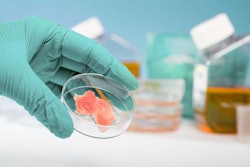
As the availability of wheat is under pressure, nutritionists look to replace it with alternatives
As feed-grade wheat becomes scarce due to geopolitical upheaval, nutritionists look to alternative sources of energy to replace it.
Unfortunately, most professionals agree that inexpensive wheat (at least in the EU) is a thing of the past and it will be considerable time before, if ever, we get to see such abundance in imported wheat. Nevertheless, wheat has specific characteristics – some bad, some good – that we must keep in mind when formulating with alternatives.
The following list provides a good starting point of discussion with a qualified nutritionist who knows wheat and how to replace it, mostly with agro-industrial byproducts.
Phytase
Wheat contains natural phytase and, as such, the relative bioavailability (poultry) or digestibility (pigs) of phosphorus is higher compared with corn or other cereals. When removing wheat, the new formulas will need to be supplemented with extra phosphorus from inorganic sources or the dosage of the supplemented phytase (if used) will need to be adjusted.
Xylanase
Some diets using wheat varieties high in non-starch polysaccharides contain an additional enzyme – a xylanase. This contributes a small amount of energy, and reduces the viscosity of the gut digesta, which is an impeding factor for poultry. When removing wheat from such formulas, there is no reason to continue using a wheat-specific enzyme such as a xylanase.
Threonine
The second limiting amino acid in wheat is threonine. In contrast, the second limiting amino acid in corn is methionine. Replacing wheat with corn should not be done at a 1:1 ratio. A complete reformulation is required to ensure all amino acids are accounted for correctly. The same is true for all other nutrients and energy.
Niacin and choline
Niacin in corn is virtually unavailable, but not so in wheat or other cereals. So, if corn is used instead of wheat and the premix is marginal in niacin, some extra niacin may be needed to make up for the deficiency of this vitamin in corn. In terms of choline, wheat contains almost twice as much as corn. For some animals, this is not a problem, but for other species that require choline supplementation, switching from one cereal to another ingredient may require adjusting the whole vitamin premix.
Pelleting
Wheat contains a specific group of proteins – glutens – that give the well-known plasticity in bread. The same proteins also cause pellets to be hard and well formed, without the need for a pelleting agent. In contrast, some agro-industrial products contain excess fibers that may cause pellets to be friable. This may not affect animal performance, but it may cause excessive feed wastage, and reduce marketing appeal of ready-made feeds.
Wet litter/dirty eggs
As mentioned before, wheat contains non-starch polysaccharides that increase gut digesta viscosity. Apart from reducing nutrient digestibility, such increased viscosity is implicated in wet litter (broilers) and dirty eggs (layers). To counter such effect, apart from the xylanase enzyme, there are more nutritional products that are added. Again, such additives can be safely removed if the replacement to wheat does not interfere with gut digesta viscosity.
Necrotic enteritis
For some reason, wheat has been implicated with increased problems due to necrotic enteritis. Some additives, especially phytogenics, are marketed with claims against necrotic enteritis. If wheat is removed from feeds and necrotic enteritis problems subside, a nutritionist should evaluate as always if such additives are still needed.
Pigmentation
Wheat contains virtually no pigments of any value when it comes to egg yolk color. When switching to an ingredient with significant amounts of pigments, then any added pigments (synthetic or natural) many need to be adjusted to remain within customer-accepted levels of coloration. The same applies to carcass fat; for example, wheat-fed animals tend to have whiter carcass fat, whereas animals fed with corn have slightly yellowish fat.
Carcass quality
Apart from pigmentation of carcass fat, wheat tends to produce harder carcass fat, with barley producing the whitest and hardest fat of all cereals. Softer carcass fat can be a problem with fresh pork or with processed meats like sausages. On the other hand, lean parts do not have such issues, and this is something that needs to be discussed with the processing plant.
Different mycotoxins
Corn, for example, often suffers from aflatoxins (polar), whereas wheat often suffers from non-polar mycotoxins. The selection of mycotoxin binder needs to follow the profile of the mycotoxins found on each cereal. On the other hand, certain agro-industrial products may be free from any mycotoxins, in which case a mycotoxin binder may be superfluous when wheat is removed.
In brief, wheat can be replaced by many other raw materials, if available and at the right price, but a nutritionist must be consulted to ensure the idiosyncrasies of wheat are accounted for. This is particularly important in regions that have been using wheat for ages and have thus attuned their formulations around it.















